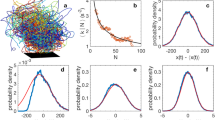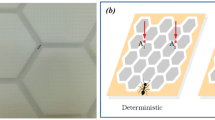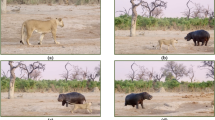Abstract
Research in social insect behaviour has provided computer scientists with powerful methods for designing distributed control and optimization algorithms. These techniques are being applied successfully to a variety of scientific and engineering problems. In addition to achieving good performance on a wide spectrum of ‘static’ problems, such techniques tend to exhibit a high degree of flexibility and robustness in a dynamic environment.
This is a preview of subscription content, access via your institution
Access options
Subscribe to this journal
Receive 51 print issues and online access
$199.00 per year
only $3.90 per issue
Buy this article
- Purchase on SpringerLink
- Instant access to full article PDF
Prices may be subject to local taxes which are calculated during checkout

Similar content being viewed by others
References
Deneubourg, J. -L. & Goss, S. Collective patterns and decision making. Ethol. Ecol. Evol. 1, 295–311 (1989).
Goss, S., Aron, S., Deneubourg, J. -L. & Pasteels, J. M. Self-organized shortcuts in the Argentine ant. Naturwissenschaften 76, 579–581 ( 1989).
Bonabeau, E., Dorigo, M. & Theraulaz, G. Swarm Intelligence: From Natural to Artificial Systems (Oxford Univ. Press, New York, 1999).
Dorigo, M., Maniezzo, V. & Colorni, A. The ant system: optimization by a colony of cooperating agents. IEEE Trans. Syst. Man Cybern. B 6, 29–41 (1996).
Dorigo, M. & Gambardella, L. M. Ant colonies for the traveling salesman problem. BioSystems 43, 73– 81 (1997).
Schoonderwoerd, R., Holland, O., Bruten, J. & Rothkrantz, L. Ant-based load balancing in telecommunications networks. Adapt. Behav. 5, 169–207 (1997).
Heusse, M., Guérin, S., Snyers, D. & Kuntz, P. Adaptive agent-driven routing and load balancing in communication networks. Adv. Compl. Syst. 1, 237– 254 (1998).
Di Caro, G. & Dorigo, M. AntNet: Distributed stigmergetic control for communications networks. J. Artif. Intell. Res. 9, 317–365 (1998).
Lumer, E. & Faieta, B. in Proc. 3rd Intl Conf. Simulation of Adaptive Behavior: From Animals to Animats 3 (eds Cliff, D., Husbands, P., Meyer, J. -A. & Wilson, S. W.) 501–508 (MIT Press, Cambridge, MA, 1994).
Kuntz, P., Snyers, D. & Layzell, P. A stochastic heuristic for visualizing graph clusters in a bi-dimensional space prior to partitioning. J. Heuristics 5, 327–351 ( 1999).
Chen, K. A simple learning algorithm for the traveling salesman problem. Phys. Rev. E 55, 7809–7812 (1997).
Baluja, S. & Caruana, R. in Proc. 12th Intl Conf. Machine Learning (eds Prieditis, A. & Russell, S.) 38–46 (Morgan Kaufmann, Palo Alto, 1995).
Ward, M. There's an ant in my phone. New Sci. 2118, 32–35 (1998).
Robinson, G. E. Regulation of division of labour in insect societies. Annu. Rev. Entomol. 37, 637–665 ( 1992).
Sobkowski, A. et al. in Bio-Computation and Emergent Computing (eds Lundh, D., Olsson B. & Narayanan, A.) 36–45 (World Scientific, Singapore, 1997).
Franks, N. R. & Sendova-Franks, A. B. Brood sorting by ants: distributing the workload over the work surface. Behav. Ecol. Sociobiol. 30, 109–123 ( 1992).
Deneubourg, J. -L. et al. in Proc. 1st Conf. Simulation of Adaptive Behavior: From Animals to Animats (eds Meyer, J. A. & Wilson, S. W.) 356– 365 (MIT Press, Cambridge, MA, 1991).
Cao, Y. U., Fukunaga, A. S. & Kahng, A. B. Cooperative mobile robotics: antecedents and directions. Autonomous Robots 4, 7– 27 (1997).
Martinoli, A., Yamamoto, M. & Mondada, F. in: Proc. 4th European Conf. Artificial Life (eds Husbands, P. & Harvey, I.) (MIT Press, Cambridge, MA, 1997).
Nilsson, M. & Simsarian, K. T. in Proc. 1995 IEEE/RSJ Intl Conf. Intelligent Robots and Systems 556–561 (IEEE Computer Society Press, Los Alamitos, 1995).
Kube, C. R. & Zhang, H. Collective robotics: from social insects to robots. Adaptive Behavior 2, 189– 218 (1994).
Kube, C. R. & Zhang, H. Task modelling in collective robotics. Autonomous Robots 4, 53– 72 (1997).
Sudd, J. H. The transport of prey by ants. Behaviour 25, 234–271 (1965).
Franks, N. R. Teams in social insects: group retrieval of prey by army ants (Eciton burchelli , Hymenoptera: Formicidae). Behav. Ecol. Sociobiol. 18, 425–429 (1986).
Moffett, M. W. Cooperative food transport by an asiatic ant. Nat. Geogr. Res. 4, 386–394 ( 1988).
Kelly, K. New Rules for the New Economy (Viking, New York, 1998 ).
Walters, T. in Proc. PPSN V, Conference on Parallel Problem-Solving from Nature (eds Eiben, A. E., Bäck, T., Schoenauer, M. & Schwefel, H.-S.) 813 –822 (Springer, Berlin, 1998).
Stützle, T. & Hoos, H. in Proc. IEEE Intl Conf. Evolutionary Computation (eds Bäck, T., Michalewicz,Z. & Yao,X.), 309–314 (IEEE Computer Society Press, Los Alamitos, 1997).
Van der Put, R. & Rothkrantz, L. in Simulation Practice and Theory (in the press).
Costa, D. & Hertz, A. Ants can colour graphs. J. Op. Res. Soc. 48, 295–305 (1997).
Michel, R. & Middendorf, M. in Proc. PPSN V, Conference on Parallel Problem-Solving from Nature (eds Eiben, A. E., Bäck, T., Schoenauer, M. & Schwefel, H.-S.) 692–701 (Springer, Berlin, 1998).
Gambardella, L. M., Taillard, E. D. & Dorigo, M. Ant colonies for the quadratic assignment problem. J. Op. Res. Soc. 50, 167–176 (1999).
Stützle, T. & Hoos, H. in Meta-Heuristics: Advances and Trends in Local Search Paradigms for Optimization (eds Voss, S., Martello, S., Osman, I. H. & Roucairol, C.) 313– 329 (Kluwer Academic, Boston, 1999).
Maniezzo, V. & Colorni, A. The ant system applied to the quadratic assignment problem. IEEE Trans. Knowledge Data Engin. 11, 769–778 (1999).
Bauer, A., Bullnheimer, B., Hartl, R. F. & Strauss, C. in Proc. Congr. Evolutionary Computation (CEC’99) 1445– 1450 (IEEE Press, Piscataway, NJ, 1999).
Bullnheimer, B., Hartl, R. F. & Strauss, C. in Meta-Heuristics: Advances and Trends in Local Search Paradigms for Optimization (eds Voss, S., Martello, S., Osman, I. H. & Roucairol, C.) 109–120 (Kluwer Academic, Boston, 1999).
Gambardella, L. M., Taillard, E. D. & Agazzi, G. in New Ideas in Optimization (eds Corne, D., Dorigo, M. & Glover, F.) 63–76 (McGraw-Hill, London, 1999).
Leguizamón, G. & Michalewicz, Z. in Proc. Congr. Evolutionary Computation (CEC’99) 1459– 1464 (IEEE Press, Piscataway, NJ, 1999).
Maniezzo, V. & Carbonaro, A. An ANTS heuristic for the frequency assignment problem. Future Generation Comput. Syst. J. 16, 927–935 (2000).
Gambardella, L. M. & Dorigo, M. Ant colony system hybridized with a new local search for the sequential ordering problem. INFORMS J. Comput. (in the press).
Bertsekas, D. & Gallager, R. Data Networks (Prentice Hall, Englewood Cliffs, 1992).
Acknowledgements
E. B. is supported by the Interval Research Fellowship at the Santa Fe Institute. E. B. and G.T. are supported in part by a grant from the GIS (Groupement d'Intérêt Scientifique) Sciences de la Cognition. G. T. is supported by a grant from the Conseil Régional Midi-Pyrénées. M. D. acknowledges support from the Belgian FNRS, of which he is a Research Associate.
Author information
Authors and Affiliations
Corresponding author
Rights and permissions
About this article
Cite this article
Bonabeau, E., Dorigo, M. & Theraulaz, G. Inspiration for optimization from social insect behaviour. Nature 406, 39–42 (2000). https://doi.org/10.1038/35017500
Issue Date:
DOI: https://doi.org/10.1038/35017500
Comments
By submitting a comment you agree to abide by our Terms and Community Guidelines. If you find something abusive or that does not comply with our terms or guidelines please flag it as inappropriate.



